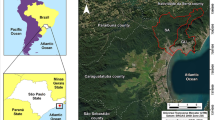Abstract
Avalanches and landslides, induced by the Wenchuan Earthquake on May 12, 2008, resulted in a lot of disaggregated, solid material on slopes that could be readily mobilized as source material for debris flows. Rainstorms triggered numerous slope debris flows with great damage to highways and rivers over the subsequent two years. Slope debris flows (as opposed to channelized debris flows) are defined as phenomena in which high-concentration mixtures of debris and water flow down slopes for short distances to highways and river banks. Based on field investigations and measurements of 19 slope debris flows, their main characteristics and potential mitigation strategies were studied. High rainfall intensity is the main triggering factor. Critical rainfall intensities for simultaneous occurrence of single, several and numerous slope debris flow events were 20 mm/day, 30mm/day, and 90 mm/day, respectively. Field investigations also revealed that slope debris flows consist of high concentrations of cobbles, boulders and gravel. They are two-phase debris flows. The liquid phase plays the role of lubrication instead of transporting medium. Solid particles collide with each other and consume a lot of energy. The velocities of slope debris flows are very low, and their transport distances are only several tens of meters. Slope debris flows may be controlled by construction of drainage systems and by reforestation.
Similar content being viewed by others
References
BAGNOLD, R. A. 1956. The flow of cohesionless grains in fluids. Philosophical Transaction of the Royal Society of London, Series A. 249(964): 235–297.
BAGNOLD, R. A. 1954. Experiments on a Gravity Free Dispersion of Large Solid Spheres in a Newtonian Fluid under Shear. Proc. Roy. Soc. London 225 A: 49–63.
CHEN, C. L. 1988. Generalized Viscoplastic Modeling of Debris Flow. Journal of Hydraulic Engineering 114: 237–258.
IVERSON, R. M. and DENLINGER, R. P. 1987. The Physics of Debris Flows-A Conceptual assessment. In: Beschta, R. L. et al. (eds.), Erosion and Sedimentation in the Pacific Rim, International Association of Hydrological Sciences Publication No. 165. Pp. 155–165.
JOHNSON, A. 1970. Physical Processes in Geology. California, USA: Freeman Cooper & Company.
JULIEN, P. Y. and LAN, Y. 1991. Rheology of Hyperconcentrations. Journal of Hydraulic Engineering 107: 346–353.
KANG, Z. C., LI, Z. F., MA, A. N., and LUO, J. T. 2004. Research of debris flows in china, China: Science Press. Pp. 79–81. (In Chinese)
KANG Zhicheng. 1995. Dynamic analysis of stable movement in viscous debris flow. Mountain Research 13(2): 128–132.
LIN Ching-Weei, LIU Shou-Heng, LEE Sen-Yuan, and Liu Cheng-Chien. 2006. Impacts of the Chi-Chi earthquake on subsequent rainfall-induced landslides in central Taiwan. Engineering Geology 86:87–101
LIU, C., XU, G., XU, G., HUANG, Y., KONG, Y. Y., CHENG, Z.L. and YANG, J. 2007. Study of Precipitation Factor inducing Debris Flow on Slope—A Case Study of Beibei, Chongqing. Bulletin of Soil and Water Conservation (01): 51–54.
LIU, C. 2007. The Comprehensive Research about the Possibility of Slope Debris Flow Occurrence. Mechanics. 127: 453–472.
LIU, C., XU, G., YANG, J., and CHENG, Z. L. 2006. Study of Slope Factor Inducing Debris Flow on Slope—A Case Study of Beibei, Chongqing. The Chinese Journal of Geological Hazard and Control (04):165–168.
SAVAGE, S. B. 1984. The Mechanics of Rapid Granular Flows. Advances in Applied Mechanics 24: 289–366.
SAVAGE, S. B. and MCKEOWN, S. 1983. Shear Stress Developed During Rapid Shear of Dense Concentrations of Large Spherical Particles Between Concentric Cylinders. Journal of Fluid 127: 453–472.
SHEN, H. H. and ACKERMANN, N. L. 1982. Constitutive Relationships for Fluid-Solid Mixtures. Journal of Engineering Mechnics Division 108: 748–763.
TAKAHASHI, T. 1978. Mechanical characteristics of debris flow. Hydraulic Division 104: 1153–1169.
TAKAHASHI, T. 1980. Debris flow on prismatic open channel. Hydraulic Division 106: 381–386.
TAKAHASHI, T. 1981. Debris flows. Fluid Mechanics. 13:57–77.
TAKAHASHI, T. 2007. Debris Flows-mechanism, prediction and countermeasures, London: Taylor & Francis/Balkema. Pp. 1–30.
WANG Zhaoyin. 1999. Field investigation into debris flow mechanism. International Journal of Sediment Research (4): 10–22.
WANG Zhaoyin. 1993. A study on debris flow surges. Hydraulic Engineering 2: 1616–1621.
WANG Zhaoyin, Lee J. H. W. and Melching C.S., 2010. Integrated River Training and Management, Berlin and Beijing: Springer Verlag and Tsinghua Press. Pp. 1–200.
WANG, Z. Y. 2002. Free Surface Instability of Non-Newtonian Laminar Flows. Journal of Hydraulic Research, IAHR 40(4): 449–460.
WANG, Z.Y. and ZHANG, X.Y.. 1990. Initiation and Laws of Motion of Debris Flows. Hydraulic/Hydrology of Arid Land, ASCE. Pp. 596–601.
WANG, S. G. 1999. Hazard of Debris Flow on Slope and its Control. The Chinese Journal of Geological hazard and control(03): 46–51.
WANG, Z. Y. 2001. Experimental study on debris flow head and the energy theory. Journal of Hydraulic Engineering (03):20–28.
WANG, Z. Y., Cui, P., and Yu, B., 2001. The mechanism of debris flow and drag reduction. Journal of Natural Disasters (03):37–43.
WANG Zhaoyin, WANG Guangqian, and LIU Cheng. 2005. Viscous and Two-Phase Debris Flows in Southern Chinas’s Yunnan Plateau. Water International 30(1):14–23.
WANG, Z. Y., LIU, D. D., and SHI, W. J. 2009. Grain erosion induced by the Wenchuan Earthquake and control strategy. Science of Soil and Water Conservation in china 7(6):7–15.
WANG Zhaoyin, CUI Peng, and WANG Ruiyu. 2009. Mass movements triggered by the Wenchuan earthquake and management strategies of quake lakes. River Basin Management 7(1):1–12.
YANO K, DAIDO A. 1965. Fundamental study on mudflow. Bull. Disaster Prevention Research Institute. Kyoto University. Japan 14: 269–283.
ZENG, F. W. 2005. Study of Movement Mechanism and Happened of Debris Flow of Hillslope.Thesis. Southwestern Normal University.
ZHANG, Y. S., QU, Y. X., HE, F., WU, S. R., YAN, Z. X., YANG, W. M., and SHI, J. S. 2005. Research on the formation mechanism of debris flow on slope around Ningshan County in the Hinterland of the Qinling Orogen. Hydrogeology and Engineering Geology(05): 84–88.
Author information
Authors and Affiliations
Corresponding author
Rights and permissions
About this article
Cite this article
Li, Y., Wang, Z., Shi, W. et al. Slope debris flows in the Wenchuan Earthquake area. J. Mt. Sci. 7, 226–233 (2010). https://doi.org/10.1007/s11629-010-2014-2
Received:
Accepted:
Published:
Issue Date:
DOI: https://doi.org/10.1007/s11629-010-2014-2




